Optimization of the Composition of Mineral–Asphalt Mixture for Pothole Repairs Based on Reclaimed Asphalt Using Innovative Chemical Activators
Abstract
1. Introduction
2. Materials for Testing and Characterization of Prepared Additives
2.1. Reclaimed Asphalt
2.2. Selection of Activating Additives
3. Methodology for Optimizing Additive Content Using the MSCR Test
3.1. MSCR Test Results
3.2. Proposal of a Method for Determining Dosage Based on Compliance to Permanent Deformations and Elastic Recovery MSCR Parameters
3.3. The Influence of Activating Additives on Asphalt Recovered from Reclaimed Material
4. Indirect Tensile Strength Tests on Samples with Optimal Content of Chemical Activators W1 and W2
5. Summary and Conclusions
5.1. Conclusions Based on Binder Tests
- For each of the analyzed additives (i.e., W1 and W2) there is an optimal mass content in relation to the binder, which allows for obtaining the best values of basic features (penetration, Fraass breaking point, etc.) and rheological properties determined in the MSCR test;
- The consistency of the W2 additive is much more viscous than that of the W1 additive, which significantly affects the obtained results, i.e., at the dosage marked as d1, it can be assumed that the 35/50 aged binder mixtures with the W1 additive are liquids, so the MSCR test is not adequate in this case;
- Activators W1 and W2 do not affect binders in a way analogous to classical modifications with SBS copolymer. MSCR results obtained for mixtures at different mass content levels place them below the curve separating typical modified and unmodified asphalt binders;
- Physical aging (time elapsed since the mixtures were made) has a positive or negative effect on MSCR parameters, depending on the dosage. This conclusion allows us to formulate the observation that there is an optimal dosage level for each additive;
- Additives W1 and W2 have shown their usefulness in activating the binder recovered from RAP. This is manifested by increased compliance to permanent deformations while maintaining a high value of elastic recovery at a low-stress level. It is worth emphasizing, however, that excessive amounts of additives reverse this tendency;
- Adding both W1 and W2 activators has a clear effect on the change in the consistency of binder recovered from RAP. It significantly increases penetration at 25 °C, lowers the softening temperature, favorably lowers the breaking temperature, and improves the elastic recovery. Activator W1 is distinguished by significantly greater efficiency, where positive changes in the properties of the old binder can be obtained using half the activator content. These changes are clearly more beneficial, because, at a comparable softening temperature and significantly higher penetration at 25 °C, better results were obtained in terms of compliance to permanent deformations and elastic recovery.
5.2. Conclusions Based on Indirect Tensile Strength Tests of Repair Mixtures
- With optimal doses of activators W1 and W2, very high values of average contact stresses were obtained, exceeding 3 [MPa] in almost all cases (in the best variants for the matured mixture even 6 [MPa]). These values present indirect tensile strength values equal to 0.24 [MPa] and 0.48 [MPa], respectively;
- The influence of the maturation time on the obtained strengths was observed. During the first two days, the indirect tensile strength decreases slightly and then increases significantly in the following days (tests were performed after 1, 2, 3, 7, 14, and 28 days);
- For a selected group of samples prepared in the Marshall apparatus, a study of the regenerative capabilities of the analyzed repair mixtures was conducted. Namely, after performing the indirect tensile strength test on the material of the split samples, further samples were prepared and the tests were carried out again, obtaining results at a comparable level. This means that the proposed mixture has the ability to self-repair after the occurrence of cracks (these results were not presented above);
- The water and frost resistance test was conducted in a standard manner, obtaining ITSR of 51.1% and on samples conditioned for 28 days (ITSR is 56.2%). Analyzing these results in relation to typical “hot” mixtures, it can be seen that freezing cycles significantly reduce the tensile strength of the tested mixture for pothole repairs. This conclusion is based only on initial test results and has to be justified in a wider testing campaign.
5.3. Conclusions Based on Preliminary Application in Real Conditions
5.4. Discussion of Future Work
- Functional comparative studies of the proposed pothole repair mixture against commercially used materials;
- Expansion of testing the properties of the obtained product, including rutting resistance, surface abrasion (DSD), fracture resistance (SCB), and resistance to water and frost action (ITSR);
- To enhance the interpretation of the obtained results, it is planned to integrate relevant concepts from structural integrity monitoring and hybrid modeling techniques. Fuzzy similarity can be employed in the context of this study to evaluate the performance of modified binders and recycled mixtures in a more flexible and continuous manner, accounting for variability in experimental data and operating conditions. This approach enables the comparison of similar mechanical properties despite numerical differences, the classification of performance without rigid thresholds, and the analysis of mixture stability under diverse environmental conditions [46];
- Carrying out extensive field tests of the proposed mixtures. These studies will involve proper preparation of pothole edges, repairs conducted under varying weather conditions, and systematic monitoring of the repaired potholes, traffic, and weather.
Author Contributions
Funding
Institutional Review Board Statement
Informed Consent Statement
Data Availability Statement
Conflicts of Interest
References
- Al-Hashimi, Z.; Al-Busaltan, S.; Al-Abbas, B. Advancements and Challenges in the Use of Cold Mix Asphalt for Sustainable and Cost-Effective Pavement Solutions. E3S Web Conf. 2023, 427, 03006. [Google Scholar] [CrossRef]
- Shanbara, H.K.; Dulaimi, A.; Al-Mansoori, T.; Al-Busaltan, S.; Herez, M.; Sadique, M.; Abdel-Wahed, T. The future of eco-friendly cold mix asphalt. Renew. Sustain. Energy Rev. 2021, 149, 111318. [Google Scholar] [CrossRef]
- Hafezzadeh, R.; Autelitano, F.; Giuliani, F. Asphalt-based cold patches for repairing road potholes—An overview. Constr. Build. Mater. 2021, 306, 124870. [Google Scholar] [CrossRef]
- Jain, S.; Singh, B. Cold mix asphalt: An overview. J. Clean. Prod. 2021, 280, 124378. [Google Scholar] [CrossRef]
- Xiao, F.; Yao, S.; Wang, J.; Li, X.; Amirkhanian, S. A literature review on cold recycling technology of asphalt pavement. Constr. Build. Mater. 2018, 180, 579–604. [Google Scholar] [CrossRef]
- Zhao, L.; Tan, Y. A summary of cold patch material for asphalt pavements. Adv. Mater. Res. 2011, 168–170, 864–869. [Google Scholar] [CrossRef]
- Dash, S.S.; Chandrappa, A.K.; Sahoo, U.C. Design and performance of cold mix asphalt—A review. Constr. Build. Mater. 2022, 315, 125687. [Google Scholar] [CrossRef]
- Yang, Y.; Qian, Z.; Song, X. A pothole patching material for epoxy asphalt pavement on steel bridges: Fatigue test and numerical analysis. Constr. Build. Mater. 2015, 94, 299–305. [Google Scholar] [CrossRef]
- Bi, Y.; Li, R.; Han, S.; Pei, J.; Zhang, J. Development and performance evaluation of cold-patching materials using waterborne epoxy-emulsified asphalt mixtures. Materials 2020, 13, 1224. [Google Scholar] [CrossRef]
- Zhang, Z.; Wang, S.; Lu, G. Properties of new cold patch asphalt liquid and mixture modified with waterborne epoxy resin. Int. J. Pavement Eng. 2020, 21, 1606–1616. [Google Scholar] [CrossRef]
- Kowalski, K.J.; Bańkowski, W.; Król, J.B.; Andersen, B.H.; Komkova, A.; Casado Barrasa, R. Practical Application of Sustainable Road Structure: Mechanical and Environmental Approach. Appl. Sci. 2022, 12, 11914. [Google Scholar] [CrossRef]
- Kobayashi, K.; Kaito, K.; Fujiwara, E.; Mori, H.; Yamamoto, S.; Fujioka, Y.; Yamada, M. Durabililty Analysis of Pothole Patching Mixture in Snowy Regions. J. Jpn. Soc. Civ. Eng. Ser. E1 (Pavement Eng.) 2011, 67, 22–37. [Google Scholar] [CrossRef]
- Dong, Q.; Huang, B.; Zhao, S. Field and laboratory evaluation of winter season pavement pothole patching materials. Int. J. Pavement Eng. 2014, 15, 279–289. [Google Scholar] [CrossRef]
- Chen, F.; Liu, K.; Tan, Y.; Ye, S.; Xu, H.; Ouyang, J. Factors Influencing the Interfacial Bonding Characteristics Between Cold Patching Asphalt Mixture and the Old Pavement. Front. Mater. 2020, 7, 208. [Google Scholar] [CrossRef]
- Karimi, H.R.; Khedri, E.; Aliha, M.R.M.; Shaker, H.; Jafari Haghighatpour, P. Repair efficiency evaluation for cracked asphalt mixture pavement in different ambient temperatures using bitumen and polymer concrete as repair materials. Constr. Build. Mater. 2023, 369, 130556. [Google Scholar] [CrossRef]
- Byzyka, J.; Rahman, M.; Chamberlain, D.A. An innovative asphalt patch repair pre–heating method using dynamic heating. Constr. Build. Mater. 2018, 188, 178–197. [Google Scholar] [CrossRef]
- Hafezzadeh, R.; Autelitano, F.; Giuliani, F. Performance-related methods for the characterization of cold mix patching materials used in asphalt pavements maintenance. Case Stud. Constr. Mater. 2023, 19, e02600. [Google Scholar] [CrossRef]
- Collop, A.C.; Sutanto, M.H.; Airey, G.D.; Elliott, R.C. Development of an automatic torque test to measure the shear bond strength between asphalt. Constr. Build. Mater. 2011, 25, 623–629. [Google Scholar] [CrossRef]
- Kim, Y.R. Modeling of Asphalt Concrete; McGraw-Hill Construction: Brookhaven, GA, USA, 2009; ISBN 0071596518. [Google Scholar]
- Kukiełka, J.; Bańkowski, W.; Mirski, K. Asphalt-cement concretes with reclaimed asphalt pavement and rubber powder from recycled tire. Materials 2021, 14, 2412. [Google Scholar] [CrossRef]
- Cheng, H.; Liu, J.; Sun, L.; Liu, L.; Zhang, Y. Fatigue behaviours of asphalt mixture at different temperatures in four-point bending and indirect tensile fatigue tests. Constr. Build. Mater. 2021, 273, 121675. [Google Scholar] [CrossRef]
- Zheng, Y.P.; Choi, A.P.C.; Ling, H.Y.; Huang, Y.P. Simultaneous estimation of Poisson’s ratio and Young’s modulus using a single indentation: A finite element study. Meas. Sci. Technol. 2009, 20, 045706. [Google Scholar] [CrossRef]
- Gajewski, M. Comparison of rheological properties of chosen elastomers used in production of bridge bearings. Roads Bridg. Drog. Most. 2017, 16, 47–64. [Google Scholar] [CrossRef]
- Pirmohammad, S.; Ayatollahi, M.R. Asphalt concrete resistance against fracture at low temperatures under different modes of loading. Cold Reg. Sci. Technol. 2015, 110, 149–159. [Google Scholar] [CrossRef]
- Fernández-Gómez, C.; Darío, W.; Quintana, R.; Alexander, H.; Lizcano, R.; Fernández-Gómez, W.D.; Rondón Quintana, H.; Lizcano, F.R. A review of asphalt and asphalt mixture aging. Ing. Investig. 2013, 33, 5–12. [Google Scholar] [CrossRef]
- Das, P.K. Ageing of Asphalt Mixtures: Micro-Scale and Mixture Morphology Investigation; Architecture and the Built Environment, KTH Royal Institute of Technology: Stockholm, Sweden, 2014. [Google Scholar]
- Sirin, O.; Paul, D.K.; Kassem, E. State of the Art Study on Aging of Asphalt Mixtures and Use of Antioxidant Additives. Adv. Civ. Eng. 2018, 2018, 3428961. [Google Scholar] [CrossRef]
- Liu, F.; Wang, Q.; Zhang, X.; Zhou, Z.; Wang, X. Investigation of asphalt oxidation kinetics aging mechanism using molecular dynamic simulation. Constr. Build. Mater. 2023, 377, 131159. [Google Scholar] [CrossRef]
- PN-EN12697-2; Mieszanki Mineralno-Asfaltowe—Metoda Badania—Część 2: Oznaczanie Uziarnienia. Polish Committee for Standardization: Warszawa, Poland, 2013.
- PN-EN12697-1:2020-08; Mieszanki Mineralno-Asfaltowe. Metody Badań—Część 1: Zawartość Lepiszcza Rozpuszczalnego. Polish Committee for Standardization: Warszawa, Poland, 2020.
- Antil, B.; Elkasabi, Y.; Strahan, G.D.; Vander Wal, R.L. Development of graphitic and non-graphitic carbons using different grade biopitch sources. Carbon 2025, 232, 119770. [Google Scholar] [CrossRef]
- Antil, B.; Olhan, S.; Vander Wal, R.L. Production of Graphitic Carbon from Renewable Lignocellulosic Biomass Source. Minerals 2025, 15, 262. [Google Scholar] [CrossRef]
- PN-EN 14769; Asfalty i Lepiszcza Asfaltowe—Przyśpieszone Starzenie Długoterminowe/Kondycjonowanie w Komorze Starzenia Ciśnieniowego (PAV). Polish Committee for Standardization: Warszawa, Poland, 2012.
- PN-EN 12607-1; Asfalty i Lepiszcza Asfaltowe—Oznaczanie Odporności na Starzenie pod Wpływem Ciepła i Powietrza—Część 1: Metoda RTFOT. Polish Committee for Standardization: Warszawa, Poland, 2014.
- ASTM D7405-10; Standard Test Method for Multiple Stress Creep and Recovery (MSCR) of Asphalt Binder Using a Dynamic Shear Rheometer. ASTM: West Conshohocken, PA, USA, 2010; pp. 1028–1030.
- AASHTO TP-70; Multiple Stress Creep and Recovery (MSCR) of Asphalt Binder Using a Dynamic Shear Rheometer 1. American Association of State Highway and Transportation Officials: Washington, DC, USA, 2013.
- Zoorob, S.E.; Castro-Gomes, J.P.; Pereira Oliveira, L.A.; O’Connell, J. Investigating the Multiple Stress Creep Recovery bitumen characterisation test. Constr. Build. Mater. 2012, 30, 734–745. [Google Scholar] [CrossRef]
- Laukkanen, O.V.; Soenen, H.; Pellinen, T.; Heyrman, S.; Lemoine, G. Creep-recovery behavior of bituminous binders and its relation to asphalt mixture rutting. Mater. Struct. 2014, 48, 4039–4053. [Google Scholar] [CrossRef]
- D’Angelo, J.; Kluttz, R.; Dongré, R.; Stephens, K.; Zanzotto, L. Revision of the Superpave High Temperature Binder Specification: The Multiple Stress Creep Recovery Test. J. Assoc. Asph. Paving Technol. 2007, 76, 123–157. [Google Scholar]
- PN-EN16659:2016-02; Asfalty i Lepiszcza Asfaltowe—Badanie Cyklicznego Pełzania z Odprężeniem (MSCRT). Polish Committee for Standardization: Warszawa, Poland, 2016.
- Bastos, J.B.S.; Babadopulos, L.F.A.L.; Soares, J.B. Relationship between multiple stress creep recovery (MSCR) binder test results and asphalt concrete rutting resistance in Brazilian roadways. Constr. Build. Mater. 2017, 145, 20–27. [Google Scholar] [CrossRef]
- PN-EN 1426:2015-08; Bitumen i mieszanki bitumiczne. Oznaczanie penetracji igłą. Polish Committee for Standardization: Warszawa, Poland, 2015.
- PN-EN 1427:2015-08; Bitumen i mieszanki bitumiczne. Oznaczanie temperatury mięknienia. Metoda pierścienia i kuli. Polish Committee for Standardization: Warszawa, Poland, 2015.
- PN-EN 12593:2015-08; Bitumen i mieszanki bitumiczne. Oznaczanie temperatury łamliwości Fraassa. Polish Committee for Standardization: Warszawa, Poland, 2015.
- EN 12697-26:2012; Bituminous Mixtures—Test Methods for Hot Mix Asphalt—Part 26: Stiffness. European Committee for Standardization: Brussels, Belgium, 2012.
- Versaci, M.; Laganà, F.; Manin, L.; Angiulli, G. Soft computing and eddy currents to estimate and classify delaminations in biomedical device CFRP plates. J. Electr. Eng. 2025, 76, 72–79. [Google Scholar] [CrossRef]
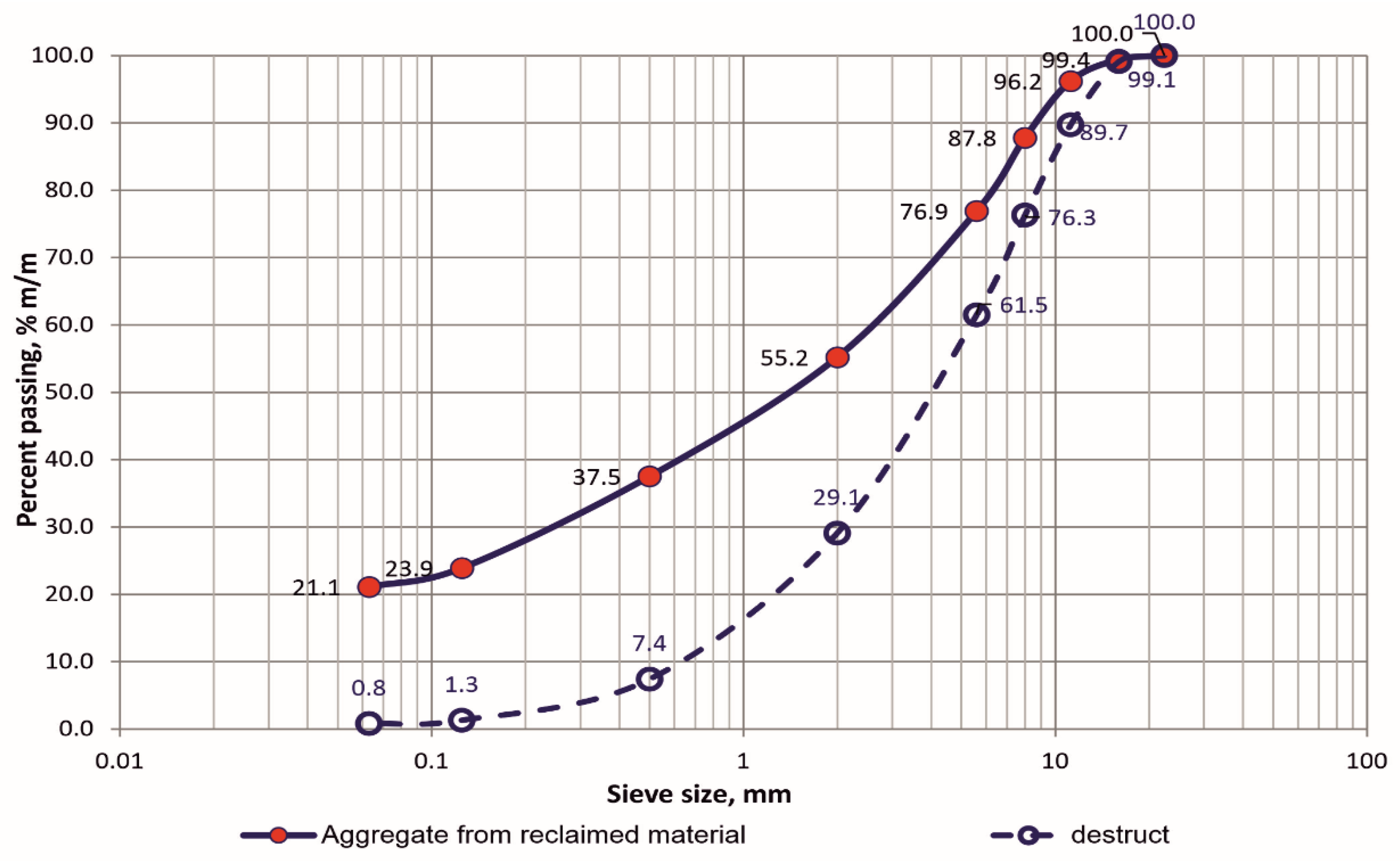
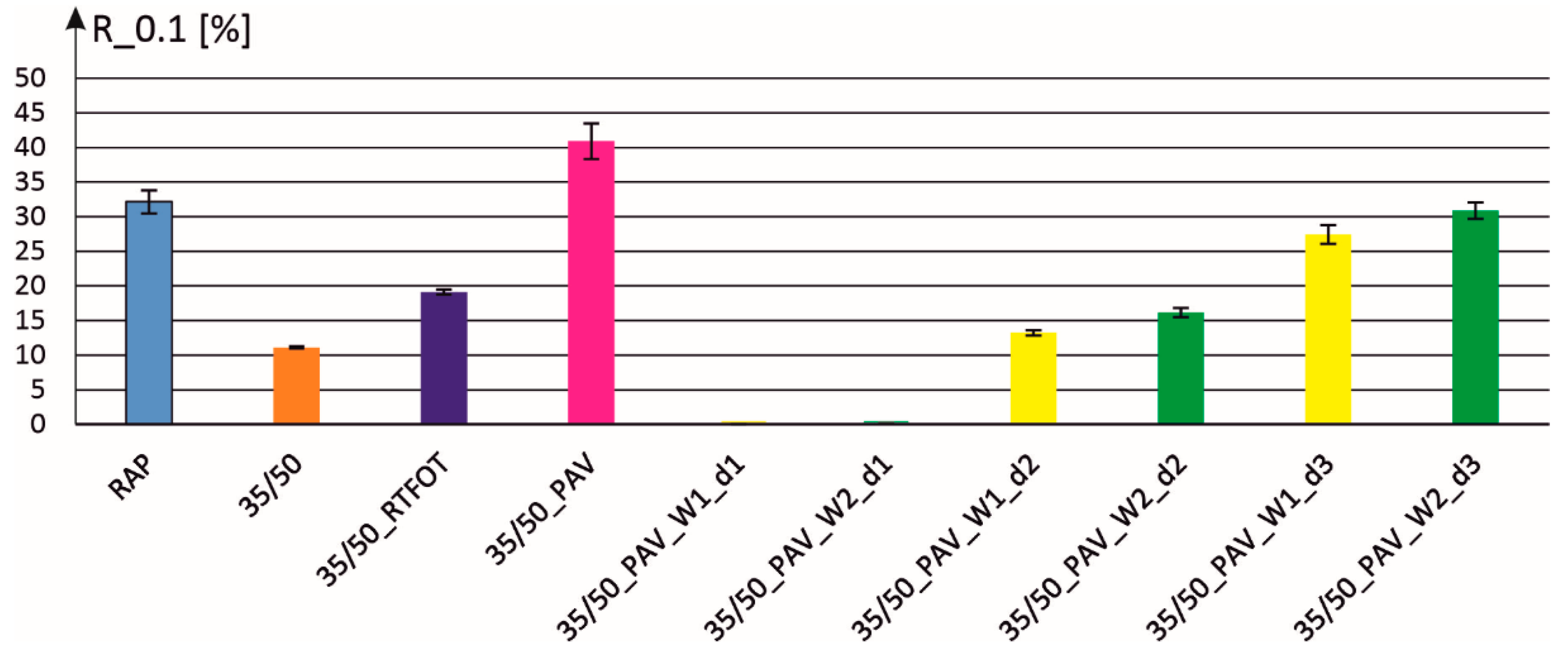
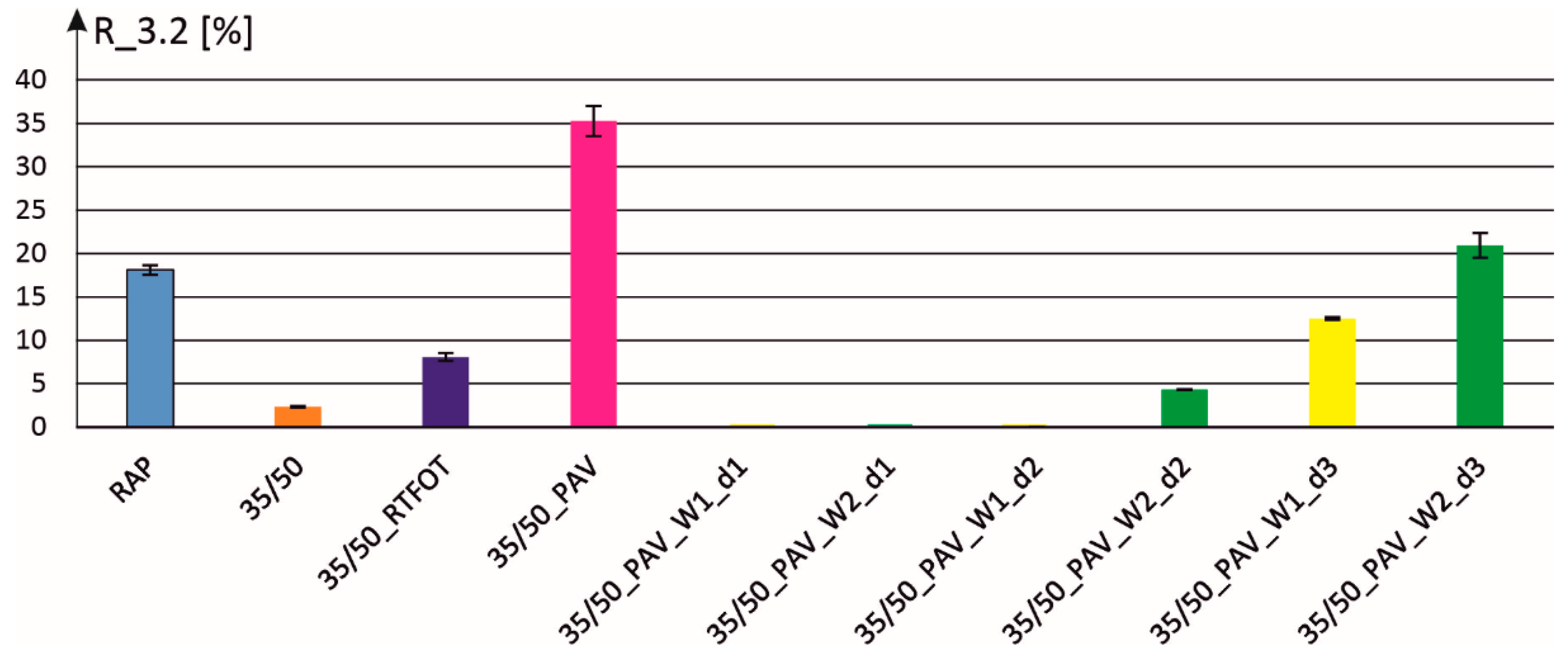
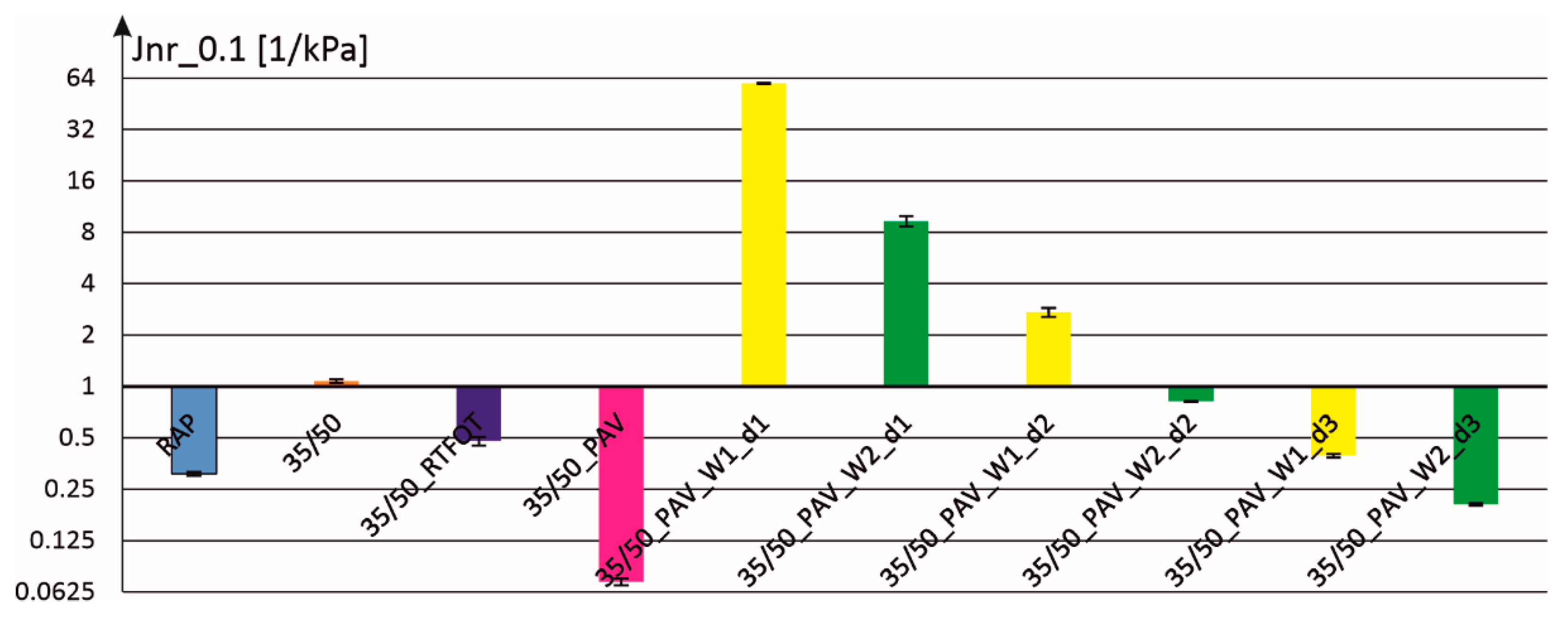
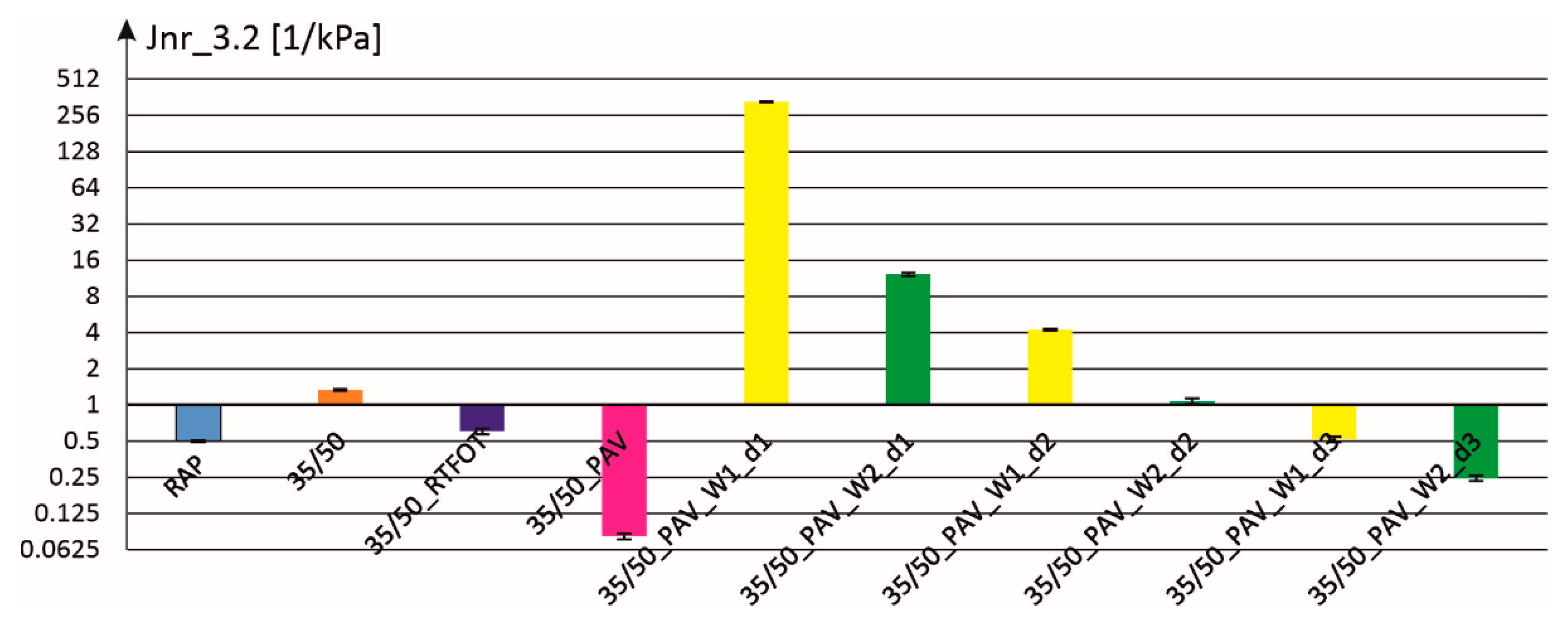



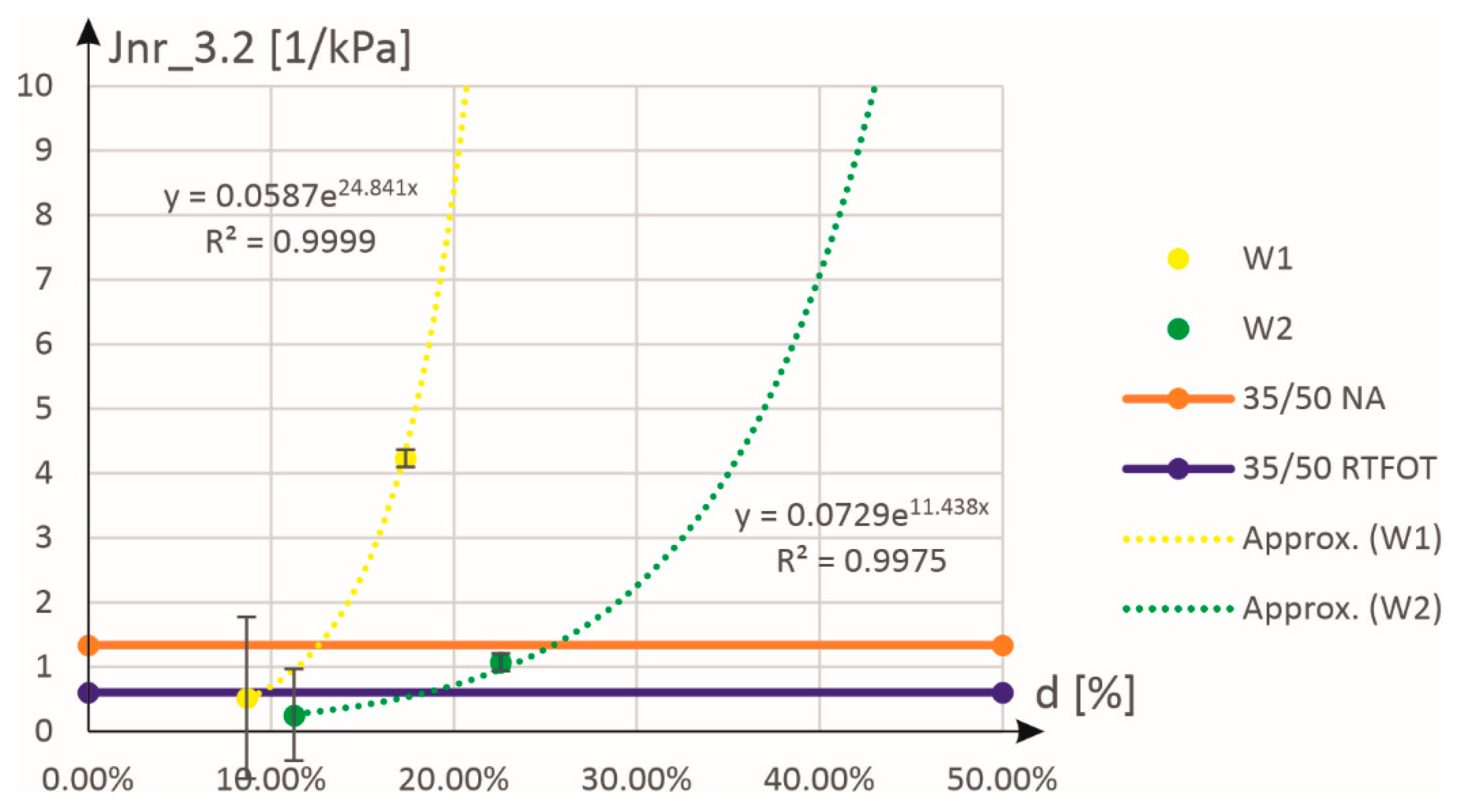




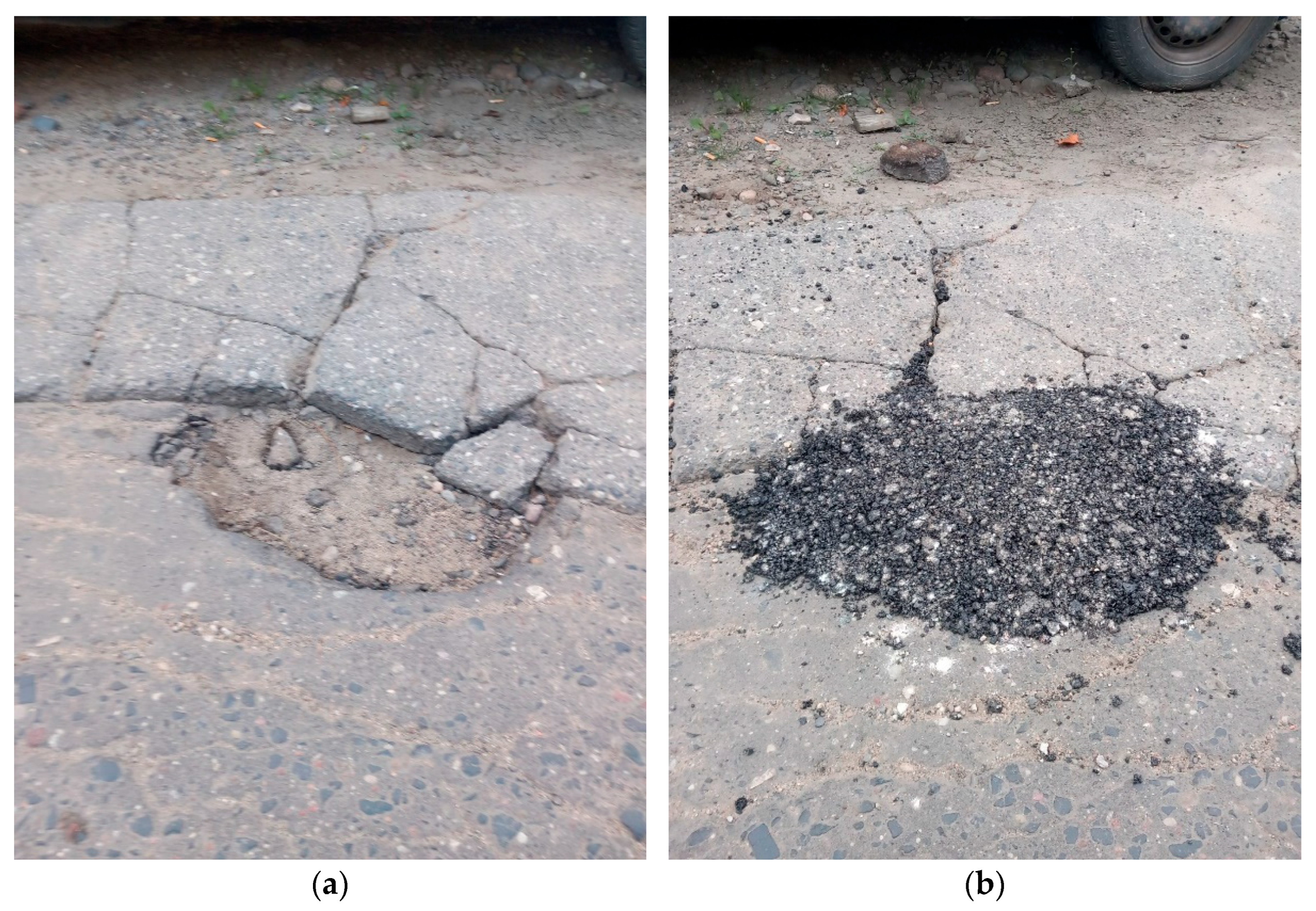
| Properties | W1 | W2 |
|---|---|---|
| Water solubility | Insoluble | Insoluble |
| Solubility in organic solvents | Soluble | Soluble |
| Appearance | Oily liquid | Oily liquid |
| Density [g/cm3] | 0.95–0.98 | 0.95–1.03 |
| Dynamic viscosity at temperature 20 [°C] | 19–23 | 31–37 |
| Dosage | d1 | d2 | d3 | |
|---|---|---|---|---|
| Additive | ||||
| W1 | 34.72% | 17.36% | 8.68% | |
| W2 | 45.09% | 22.55% | 11.28% | |
| Jnr_0.1 | Jnr_3.2 | R_0.1 | R_3.2 | |||||
|---|---|---|---|---|---|---|---|---|
| Condition | NA | RTFOT * | NA | RTFOT | NA | RTFOT | NA | RTFOT |
| W1 | 13.4 | 9.1 | 14.8 | 19.8 | 19.6 | 13.1 | 21.3 | 11.2 |
| W2 | 25.7 | 18.4 | 30.3 | 41.2 | 27.8 | 19.4 | 33.7 | 23.0 |
| Jnr_0.1 | Jnr_3.2 | R_0.1 | R_3.2 | |||||
|---|---|---|---|---|---|---|---|---|
| Parameter | a * | b | a | b | a | b | a | b |
| W1 | 0.0839 | 19.075 | 0.0587 | 24.841 | −19.79 | −21.099 | −9.013 | −11.607 |
| W2 | 0.0604 | 11.225 | 0.0729 | 11.438 | −22.11 | −17.167 | −15.11 | −14.087 |
| Property | Type of Binder | Standard | ||
|---|---|---|---|---|
| RAP | RAP/W1 (9.1%W1) | RAP/W2 (18.4%W2) | ||
| Penetration at temperature 25 °C, total loading 100 g, loading time 5 s, in units 0.1 [mm] | 20 | 55 | 40 | PN-EN 1426 [42] |
| Softening point R&B [°C] | 63.3 | 53.4 | 54 | PN-EN 1427 [43] |
| Fraass breaking point [°C] | −9 | −17 | −11 | PN-EN 12593 [44] |
| Mat. Time, [days] | W1 0 [°C] [MPa] | W1 20 [°C] [MPa] | W2 0 [°C] [MPa] | W2 20 [°C] [MPa] | ||||
|---|---|---|---|---|---|---|---|---|
| ACS | ITS | ACS | ITS | ACS | ITS | ACS | ITS | |
| 1 | 3.14 ± 0.12 | 0.24 ± 0.01 | 3.14 ± 0.13 | 0.24 ± 0.01 | 4.39 ± 0.64 | 0.34 ± 0.05 | 4.39 ± 0.65 | 0.34 ± 0.05 |
| 2 | 3.32 ± 0.15 | 0.26 ± 0.01 | 3.40 ± 0.09 | 0.26 ± 0.01 | 3.86 ± 0.56 | 0.30 ± 0.04 | 3.91 ± 0.58 | 0.30 ± 0.05 |
| 3 | 2.96 ± 0.12 | 0.23 ± 0.01 | 3.10 ± 0.18 | 0.24 ± 0.01 | 4.35 ± 0.28 | 0.34 ± 0.02 | 4.51 ± 0.93 | 0.35 ± 0.07 |
| 7 | 3.44 ± 0.03 | 0.27 ± 0.02 | 3.52 ± 0.39 | 0.27 ± 0.03 | 4.34 ± 0.07 | 0.34 ± 0.01 | 4.98 ± 1.34 | 0.39 ± 0.10 |
| 14 | 3.59 ± 0.17 | 0.28 ± 0.01 | 3.95 ± 0.32 | 0.31 ± 0.02 | 4.44 ± 0.71 | 0.34 ± 0.06 | 5.32 ± 0.27 | 0.41 ± 0.02 |
| 28 | 3.37 ± 0.32 | 0.26 ± 0.01 | 3.68 ± 0.36 | 0.29 ± 0.02 | 5.47 ± 0.78 | 0.42 ± 0.06 | 6.19 ± 0.51 | 0.48 ± 0.04 |
Disclaimer/Publisher’s Note: The statements, opinions and data contained in all publications are solely those of the individual author(s) and contributor(s) and not of MDPI and/or the editor(s). MDPI and/or the editor(s) disclaim responsibility for any injury to people or property resulting from any ideas, methods, instructions or products referred to in the content. |
© 2025 by the authors. Licensee MDPI, Basel, Switzerland. This article is an open access article distributed under the terms and conditions of the Creative Commons Attribution (CC BY) license (https://creativecommons.org/licenses/by/4.0/).
Share and Cite
Gajewski, M.; Busel, D.; Bańkowski, W.; Horodecka, R.; Butko, A. Optimization of the Composition of Mineral–Asphalt Mixture for Pothole Repairs Based on Reclaimed Asphalt Using Innovative Chemical Activators. Materials 2025, 18, 2848. https://doi.org/10.3390/ma18122848
Gajewski M, Busel D, Bańkowski W, Horodecka R, Butko A. Optimization of the Composition of Mineral–Asphalt Mixture for Pothole Repairs Based on Reclaimed Asphalt Using Innovative Chemical Activators. Materials. 2025; 18(12):2848. https://doi.org/10.3390/ma18122848
Chicago/Turabian StyleGajewski, Marcin, Dzmitry Busel, Wojciech Bańkowski, Renata Horodecka, and Aleksander Butko. 2025. "Optimization of the Composition of Mineral–Asphalt Mixture for Pothole Repairs Based on Reclaimed Asphalt Using Innovative Chemical Activators" Materials 18, no. 12: 2848. https://doi.org/10.3390/ma18122848
APA StyleGajewski, M., Busel, D., Bańkowski, W., Horodecka, R., & Butko, A. (2025). Optimization of the Composition of Mineral–Asphalt Mixture for Pothole Repairs Based on Reclaimed Asphalt Using Innovative Chemical Activators. Materials, 18(12), 2848. https://doi.org/10.3390/ma18122848








